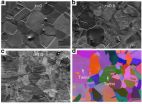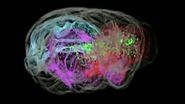(Press-News.org) VIDEO:
It's not often that we get a chance to see our planet's shadow, but a lunar eclipse gives us a fleeting glimpse. During these rare events, the full Moon rapidly...
Click here for more information.
When people in North America look up at the sky in the early morning hours of April 15, they can expect the moon to look a little different.
A total lunar eclipse is expected at this time, a phenomenon that occurs when the Earth, moon and sun are in perfect alignment, blanketing the moon in the Earth's shadow.
Although lunar eclipses happen multiple times in a year during a full moon, this eclipse will be a particularly unusual viewing opportunity for North America. Since the Earth's Western Hemisphere will be facing the moon during the eclipse, the continent will be in prime position to view it from start to finish. In addition, the eclipse will coincide with nighttime in North America. The entire continent won't be able to witness a full lunar eclipse in its entirety again until 2019.
"Sometimes they'll happen and you'll have to be somewhere else on Earth to see them," said Noah Petro, Lunar Reconnaissance Orbiter deputy project scientist at NASA's Goddard Space Flight Center in Greenbelt, Md. "Most [residents] of the continental United States will be able to see the whole thing."
For those who are awake to watch the eclipse, which is scheduled to begin around 2:00 a.m. EDT and last over three hours, Petro said there would be several changes people can witness. When the moon first enters the Earth's partial shadow, know as the penumbra, a dark shadow will begin creeping across the moon. This will give the illusion that the moon is changing phases in a matter of minutes instead of weeks.
"Eventually there will be a chunk of darkness eating the moon," Petro said.
At the eclipse's peak, around 3:45 a.m. EDT, the moon will enter the Earth's full shadow, the umbra. At this stage, the Earth's atmosphere will scatter the sun's red visible light, the same process that turns the sky red at sunset. As a result, the red light will reflect off the moon's surface, casting a reddish rust hue over it.
"It's a projection of all the Earth's sunsets and sunrises onto the moon," Petro said. "It's a very subtle effect, and if any part of the moon is illuminated in the sun, you can't really see it."
Although lunar eclipses are fairly common, Petro said they don't happen every month. Because the moon's orbit is tilted, it doesn't pass through the Earth's shadow each time it orbits the planet. This is the same reason why solar eclipses—which occur when the Earth passes through the moon's shadow—don't occur monthly.
Petro said lunar eclipses are a special treat people should take the opportunity to watch, even if it is at a late hour.
"They don't happen all the time, and the sky has to be clear," Petro said. "It really gives you a chance to look at the moon changing."
In addition to being a spectacle for North America residents, Petro said NASA's Lunar Reconnaissance Orbiter (LRO) team would be paying particular attention to this eclipse. The LRO mission, which is currently orbiting the moon, will be plunged into darkness for an extended period during the eclipse. Because the spacecraft's batteries need sunlight to charge, it will be forced to run without recharging longer than usual.
"The spacecraft will be going straight from the moon's shadow to the Earth's shadow while it orbits during the eclipse," Petro said.
While this isn't the first time LRO has orbited the moon during an eclipse, its past orbits have allowed it to pass into Earth's shadow only for a short period. This time, the spacecraft will have to pass through the complete shadow twice before the eclipse ends. However, Petro said the team expects the spacecraft to make it through the eclipse without a hitch.
"We're taking precautions to make sure everything is fine," Petro said. "We're turning off the instruments and will monitor the spacecraft every few hours when it's visible from Earth."
Although LRO would be forced to shut down its instruments for this eclipse, Petro said other lunar eclipses are a great opportunity for the mission to study how the lunar surface cools during these events, giving insight into the materials making up the surface.
While people watch the moon change in the sky April 15, the LRO team will be ready.
"For quite a while, people in LRO have been analyzing what's going to happen during this eclipse," Petro said. "We'll make sure the world knows LRO survived with no problems."
INFORMATION:
For more information about NASA's LRO mission, visit:
http://www.nasa.gov/lro
NASA's LRO mission and North America to experience total lunar eclipse
2014-04-09
ELSE PRESS RELEASES FROM THIS DATE:
Deep, integrated genomic analysis re-classifies lower-grade brain tumors
2014-04-08
Comprehensive genomic analysis of low-grade brain tumors sorts them into three categories, one of which has the molecular hallmarks and shortened survival of glioblastoma multiforme, the most lethal of brain tumors, researchers reported at the American Association for Cancer Research Annual Meeting 2014.
"The immediate clinical implication is that a group of patients with tumors previously categorized as lower grade should actually be treated as glioblastoma patients and receive that standard of care -- temozolomide chemotherapy and irradiation," said lead author Roel ...
National survey links teen binge drinking and alcohol brand references in pop music
2014-04-08
(Lebanon, 04/08/2014)— Binge drinking by teenagers and young adults is strongly associated with liking, owning, and correctly identifying music that references alcohol by brand name according to a study by the University of Pittsburgh and Dartmouth-Hitchcock Norris Cotton Cancer Center.
These findings, based on a national randomized survey of more than 2,500 people ages 15 to 23, suggests that policy and educational interventions designed to limit the influence of alcohol brand references in popular music could be important in reducing alcohol consumption in teens and ...
Searching high and low for dark matter
2014-04-08
Recently, dark matter hunters from around the world gathered at the University of California, Los Angeles for "Dark Matter 2014." The annual conference is one of the largest of its kind aimed at discussing the latest progress in the quest to identify dark matter, the unknown stuff that makes up more than a quarter of the universe yet remains a mystery.
So where does the hunt stand? Between sessions, three leading physicists at the conference spent an hour discussing the search for dark matter on several fronts.
"This conference has highlighted the progression of larger ...
The long reach of Alzheimer's
2014-04-08
LEBANON, NH – To address the burgeoning demands of Alzheimer's disease that will affect generations, new policies will have to be adopted to acknowledge the complex and unique needs of people with dementia.
The aging of the U.S. population has turned the prism to focus on the increasing number of families facing the challenge of providing care for people with dementia, said Julie P.W. Bynum, associate professor at The Dartmouth Institute for Health Policy & Clinical Practice. Writing in the April issue of Health Affairs, she says the "long reach" of Alzheimer's will ...
Experimental drug shows promise for treatment-resistant leukemias
2014-04-08
Research in mice and human cell lines has identified an experimental compound dubbed TTT-3002 as potentially one of the most potent drugs available to block genetic mutations in cancer cells blamed for some forms of treatment-resistant leukemia.
Results of the research by Johns Hopkins Kimmel Cancer Center investigators, described March 6 in the journal Blood, show that two doses a day of TTT-3002 eliminated leukemia cells in a group of mice within 10 days. The treatment performed as well as or better than similar drugs in head-to-head comparisons.
More than 35 percent ...
Location matters when it comes to deal-making, says new study
2014-04-08
Toronto – Even six-year-olds know who you sit beside matters, whether you're in first grade or at a high-powered dinner.
But now a new study, using the U.S. Senate Chamber as its laboratory, provides documented evidence of that phenomenon. It shows that where a person is located influences who they interact with and who they will turn to in order to build support for their own agenda.
For the powerful however, seating arrangements don't make much of a difference. That's because the people they need support from usually come to them.
The study's researchers chose ...
A new twist makes for better steel, researchers find
2014-04-08
PROVIDENCE, R.I. [Brown University] — Researchers from Brown University and universities in China have found a simple technique that can strengthen steel without sacrificing ductility. The new technique, described in Nature Communications, could produce steel that performs better in a number of structural applications.
Strength and ductility are both crucial material properties, especially in materials used in structural applications. Strength is a measure of how much force is required to cause a material to bend or deform. Ductility is a measure of how much a material ...
NASA's Aqua satellite reveals Tropical Cyclone Ita strengthening
2014-04-08
Tropical Cyclone Ita's maximum sustained winds have increased over the last day and NASA's Aqua satellite provided forecasters at the Joint Typhoon Warning Center with a visible look at the storm on April 8.
NASA's Aqua satellite passed over Ita at 3:30 UTC/11:30 p.m. EDT on April 7, and the Moderate Resolution Imaging Spectroradiometer provided a visible image of Tropical Cyclone Ita. The MODIS image showed a large area of strong thunderstorms south and northeast of the center of circulation. At the same time, the Atmospheric Infrared Sounder or AIRS instrument aboard ...
Scientists reveal potential link between brain development and breast cancer gene
2014-04-08
VIDEO:
Scientists at the Salk Institute have uncovered details into a surprising -- and crucial -- link between brain development and BCRA1, a gene whose mutation is tied to breast and ovarian cancer.
Click here for more information.
LA JOLLA—Scientists at the Salk Institute have uncovered details into a surprising—and crucial—link between brain development and a gene whose mutation is tied to breast and ovarian cancer. Aside from better understanding neurological damage associated ...
Why binge drinkers are slower to heal from their wounds
2014-04-08
MAYWOOD, Ill. – People who are injured while binge drinking are much slower to heal from wounds suffered in car accidents, shootings, fires, etc.
Now a new study is providing insights into why alcohol has such a negative effect on wound healing. Loyola University Chicago Stritch School of Medicine researchers report that binge alcohol exposure significantly reduced levels of key components of the immune system involved in healing.
The study by senior author Katherine A. Radek, PhD, and colleagues from Loyola's Alcohol Research Program and the Infectious Disease and ...






